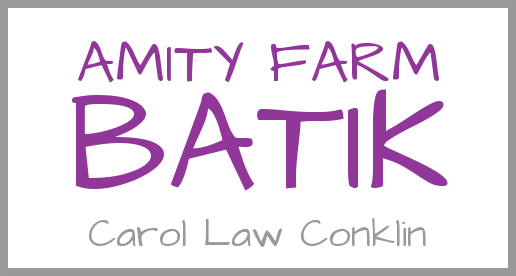




It’s Summer! July 26th. The days will be getting slightly shorter now, but it is also so much hotter. Too hot for hot wax!
Some days are too hot to work upstairs in my studio so I move downstairs to the garage where there is shade and a nice cross breeze to work in. I like to get up early this time of year to enjoy the early morning coolness and the sunrise. It’s also nice to get as much of the heat producing work done early. The mornings are cool and fresh. I’m thinking of gardens now and two new batik are pictured here, veggies in rain and veggies in sun.
My grey and calico friends are happy I’m doing my batik, as am I. You can see in these pictures my stretching table set ups. I have a compact wooden section for moderate sized pieces, you can see in the photo with me wearing green. This can be propped forward with bricks and very small pieces can be tacked in place for wax application. Fabric can also be stretched much farther back toward the wall to do very large pieces of fabric (see photo with the long batik tacked very high and at the bottom right a bricks in between that can create a very short section to work on small batik. Downstairs in the garage a different way of tacking up the fabric can be seen. I have moved down into the garage in order to be a bit cooler. The pan of hot wax still causes me to work in the evening and early morning. The drawback of course is the mosquitoes, gnats, moths and other miscellaneous flying creatures in the garage. Ironing has been moved outdoors for the summer and is done also morning and late in the day.
The photos also show me using the tjanting tool, a brass or copper bowl that has a spout and enables me to make lines of wax. There are different sizes of spouts that make smaller and larger lines. (See photo of my electric frying pan with full range of brushes and tjantings that I use.)The larger spout requires me to work very fast. In one picture you can see a cloth in my left hand. The cloth is there to can drops of wax from falling where they shouldn’t. It doesn’t stop flowing until all is used or it gets too cool. The larger spout has the most and fastest drops. At some point I will try a larger electric tjanting, but for now I dip the tjanting into an electric frying pan holding hot wax at a steady temperature. You can see another smaller pan that holds soy wax. Soy wax is a soft vegetable wax. It does not give as crisp, clear a line as my beeswax and paraffin mix. It also takes a little bit of dye into itself that gives light shades of color to the areas it has been applied to. Delicate and not as resilient as my other wax mix, it has an advantage of being able to be washed out of fabric in very hot water and detergent. Very hot is the key here.
The brush is shown applying wax as well. I have many sizes and shapes, but it does not pay to buy expensive brushes as the hot wax can and does burn the bristles back. It is best to not leave brushes or the tjantings sitting in the wax. Different wax has slightly different temperatures that are best to work with. The “flash point” must be avoided. Wax is extremely flammable.
I will post more on the batik process soon. Hope this can help you get started or give some new ideas.

Love your vegies batiks. Great to see you hard at work. While your days have started to shorten, ours have begin to lengthen and I am eager for return of warm weather.
I am new to batiking! I created a mottled design with a bright blue Procion dye (+soda ash) on a light blue cotton fabric. I used Synthrapol and hot water to rinse the finished pattern. I then applied a batik wax, and a second round of a darker procion dye + soda ash. When I’ve finally removed all of the wax, I could not see the mottled bright blue pattern in the area where the wax had been. Instead, the space only showed the original light blue. It seems almost as if the wax removed the first round of Procion bright blue dye. Is there a process that I need to do to ensure the first round of Procion dye is not lost when I apply the batik wax?
How did you remove the wax Suzanne? Did you boil it out? I only iron the wax out for my batik paintings. Perhaps the soda ash was not quite enough? or the wash with the synthrapol was
too much for it. I do not know for sure.
http://www.dharmatrading.com has lots of products with instructions and I recommend them for exact formulas and information. I have not had the experience of the color losing these patterns while rinsing or ironing out. I did use a fabric at one time that did not want to hold the dye and lost too much color when being rinsed. The fabric needs to be natural and free of sizing. Washing the fabric ahead in hot water is recommended before starting the wax and dyeing process.
I hope some of these ideas my provide help.
Best of luck with your batiking!